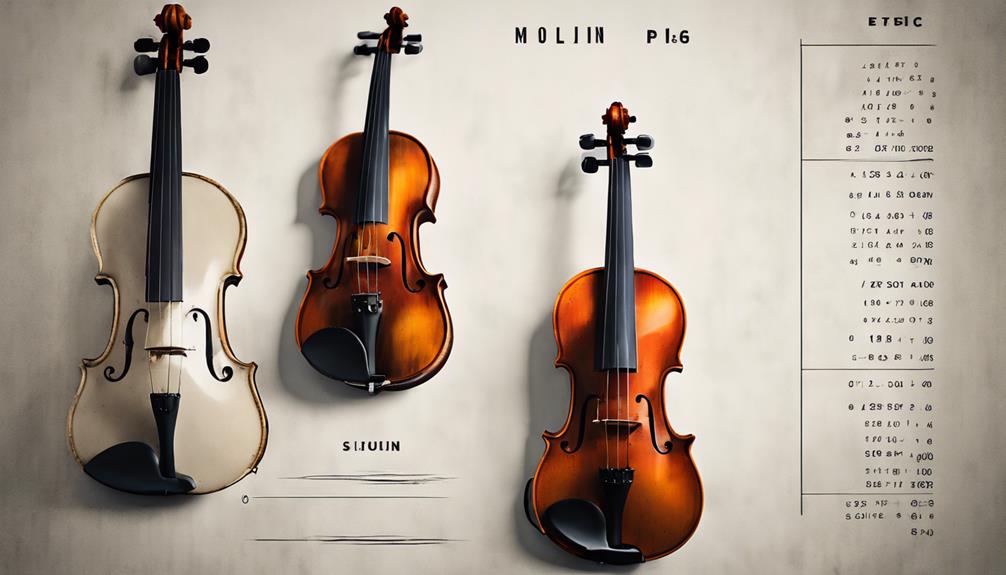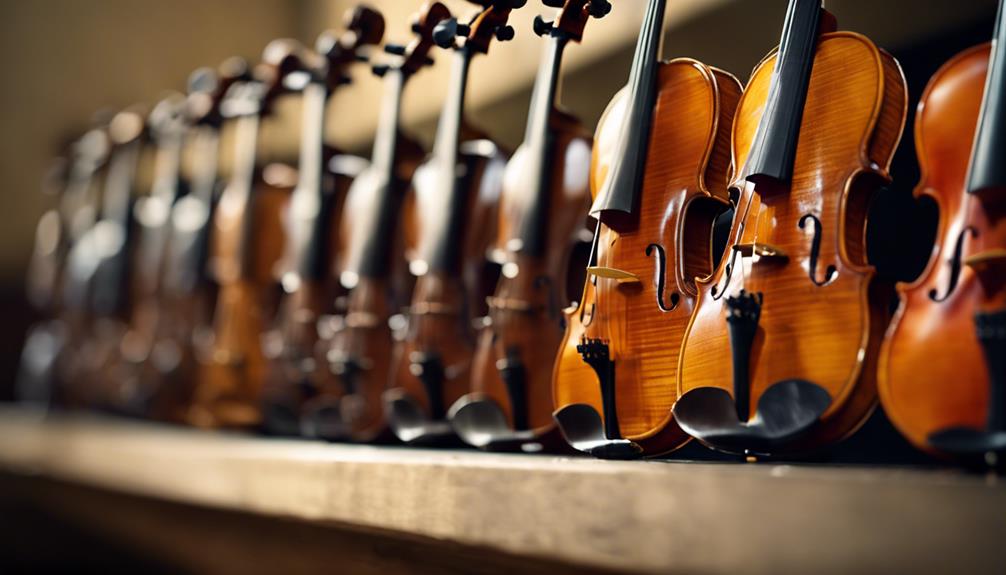When differentiating between violin and viola, note the size difference – violin is smaller than viola, impacting sound and techniques. Consider pitch range, too – violin resonates higher notes, while viola leans towards lower tones. Delve into tone – the violin emits a bright, focused sound; viola a deep, rich tone. Explore their musical roles – violin often leads melodies, while viola enriches harmonies. To conclude, focus on bowing techniques – violin requires precision in higher positions; viola, with its larger size, commands different finger positions and techniques. These nuances highlight the intricate disparities between the two string instruments.
Size and Physical Characteristics

When comparing a violin and a viola, one of the key distinguishing factors is their size and physical characteristics. The violin is typically smaller, with a body length around 14 inches, while the viola is larger, often ranging from 15 to 18 inches in body length. This size difference not only affects the overall sound produced by each instrument but also influences the techniques required to play them effectively.
Violin
When comparing a violin to a viola, it is important to point out the violin’s smaller size, typically around 14 inches in length. This compact size contributes to the violin having a shorter neck in comparison to the viola. Understanding these physical characteristics sets the foundation for comprehending the distinctions between these two string instruments.
Smaller size (about 14 inches)
Typically measuring around 14 inches in length, the violin is known for its smaller size compared to other string instruments. This compact design contributes to its unique sound quality and playability, allowing for intricate melodies and expressive performances. With significant historical significance and modern adaptations, the violin’s smaller size has played an essential role in shaping its prominence in classical music and various contemporary genres.
Shorter neck compared to viola
The violin possesses a noticeably shorter neck in comparison to the viola, a distinction that impacts both the instrument’s physical dimensions and playing characteristics. This shorter neck on the violin requires more precise finger placement due to the smaller spacing between notes. Additionally, hand size plays an essential role in comfortably maneuvering the violin’s shorter neck. The reduced neck length also influences string tension and bow weight, affecting the overall sound and playability.
Viola
The viola, larger than the violin at about 16 inches in size, is easily distinguishable by its longer neck compared to the violin. This extra length in the viola’s neck allows for the instrument to produce a deeper, richer tone than its smaller counterpart. The physical characteristics of the viola play a significant role in shaping its distinct sound and role in the orchestra.
Larger size (about 16 inches)
With a larger size of approximately 16 inches, the viola distinguishes itself from the violin based on physical dimensions. This increased size enhances sound projection, allowing for a deeper, richer tone compared to the violin. While the larger body may require more finger flexibility, it can also offer added comfort for musicians with larger hands. Overall, the viola’s size plays a significant role in shaping its unique sound and playability.
Longer neck compared to violin
A distinguishing feature of the viola, setting it apart from the violin, is its longer neck, contributing significantly to its unique physical characteristics. The extended neck of the viola allows for different finger positions and hand positioning compared to the violin. This variation in neck length influences the player’s intonation, necessitating adjustments in technique to achieve the desired sound quality and pitch accuracy in viola playing.
Pitch Range and Tuning
When comparing the violin and viola, it is essential to take into account their distinct pitch ranges and tuning. The violin typically has a higher pitch range, with its strings tuned to G, D, A, and E. In contrast, the viola has a lower pitch range, with its strings tuned to C, G, D, and A.
Violin
The violin boasts a higher pitch range compared to the viola, spanning from G3 to E7. Tuned in perfect fifths, the violin’s strings are traditionally set to G, D, A, and E from lowest to highest. This unique tuning contributes to the violin’s distinct sound and versatility in various musical genres.
Higher pitch range (G3 to E7)
In the world of string instruments, the violin boasts a higher pitch range spanning from G3 to E7, offering a diverse tonal spectrum for musicians to explore. This extended pitch range allows for intricate melodies and harmonies to be played with precision. Bowing techniques and finger positions are essential in maneuvering the violin’s pitch range effectively, enabling musicians to create rich textures and intricate musical expressions.
Tuned to G, D, A, E (from lowest to highest string)
With a tuning sequence starting from G, D, A, and E in ascending order, the violin’s pitch range is structured to offer a wide array of tonal possibilities for musicians to explore. The sound comparison between the violin and viola is influenced by this tuning, affecting playing styles. Historically, composers’ preferences for the violin’s tuning have evolved, shaping the instrument’s role in orchestral and solo compositions.
Viola
The viola offers a lower pitch range compared to the violin, spanning from C3 to A6. Tuned to C, G, D, and A, the viola’s strings are set a fifth lower than those of the violin, contributing to its distinct and rich sound quality. This difference in pitch range and tuning between the violin and viola is essential in shaping the unique timbre and tonal characteristics of each instrument.
Lower pitch range (C3 to A6)
Exploring the lower pitch range of the viola, you’ll find that it spans from C3 to A6, distinguishing it from the higher-pitched violin. This difference in pitch range is influenced by various factors, including the viola’s larger size and string differences. The lower tuning of the viola allows for a richer, deeper sound, impacting playing styles and repertoire choices, making it a unique and essential instrument in the string family.
Tuned to C, G, D, A (a fifth lower than the violin)
When comparing the tuning of the viola to that of the violin, a distinct difference is observed in the fact that the viola is historically tuned to C, G, D, A, a fifth lower than the violin. These tuning variations affect the interpretation and repertoire differences between the two instruments, with the viola offering a deeper, richer sound due to its lower pitch range, influencing the music that is composed and performed on each instrument.
Tone and Sound Characteristics

When comparing the violin and viola, it is essential to examine their unique tone and sound characteristics. The violin is known for its bright, clear, and brilliant sound, often described as sweet and vibrant. In contrast, the viola produces a deeper, warmer, and richer tone that is more mellow and full-bodied in nature.
Violin
The violin is renowned for its bright and focused sound, making it ideal for carrying melodies and higher-pitched passages in musical compositions. Its distinct tonal characteristics often shine through in solo performances, where its sound can soar above other instruments in the ensemble. Understanding the unique qualities of the violin’s tone can provide insight into its role and significance in orchestral and chamber music settings.
Bright and focused sound
The violin produces a bright and focused sound, characterized by its clear and precise tonal qualities that distinguish it from other string instruments. Its sound projection and tonal quality are enhanced by the player’s articulation and bow control. The violin’s ability to project its sound with clarity and focus makes it a versatile instrument capable of conveying a wide range of emotions and musical expressions.
Often plays melodies and higher-pitched passages
In the world of string instruments, the violin often takes the lead in playing melodies and executing higher-pitched passages due to its tonal characteristics and sound qualities. Its bright and focused sound lends itself well to leading orchestral dynamics and chamber music. Violins are frequently featured in string quartets, where they carry the melody, and in solo repertoire, showcasing their ability to soar above other instruments with their higher pitch.
Viola
When comparing the viola to the violin, you’ll notice distinctive differences in tone and sound characteristics. The viola is renowned for its rich and mellow sound, setting it apart with deeper resonance and warmer tones. These tonal qualities contribute to the unique timbre and expressive capabilities that make the viola a standout instrument in orchestral settings.
Rich and mellow sound
With its larger size and deeper resonance, the viola produces a distinctively rich and mellow sound that sets it apart from the violin. The viola’s sound projection and tonal quality offer a warm, velvety tone that is often described as more sonorous and full-bodied compared to the violin. While the viola may be slightly less accessible than the violin due to its size, its playing difficulty offers unique challenges for musicians seeking a deeper musical experience.
Known for deeper resonance and warmer tones
The viola distinguishes itself with its deeper resonance and warmer tones, setting it apart from the brighter, more penetrating sound of the violin. String differences play a significant role in this contrast. The viola’s strings are thicker and longer than the violin’s, which contributes to its rich, full-bodied sound. When comparing resonance, the viola’s larger body allows for a more profound vibration, resulting in a warmer and more resonant tone quality.
Role in Music
When considering the role of the violin and viola in music, it is essential to acknowledge their distinct contributions. The violin often takes the lead in orchestral and chamber music, carrying melodic lines with its bright and soaring tones. In contrast, the viola typically provides rich harmonies and fills in the middle voice, adding depth and warmth to the overall sound of the ensemble.
Violin
The violin plays a vital role in music as it primarily handles melody lines and leads in orchestral settings. Its versatile sound and wide range allow it to shine in solo performances, enchanting audiences with its expressive capabilities. Whether in a symphony or a concerto, the violin’s prominence and agility make it a staple in classical and contemporary music alike.
Primarily plays melody lines and leads in orchestras
In orchestras, the violin primarily takes on the role of playing melody lines and leads, showcasing its versatility and prominence in classical music compositions. It often features solo performances where its rich tones shine, but it equally excels in ensemble playing, providing harmony support to other instruments. The violin’s ability to carry intricate melodies with its bright sound makes it a cornerstone of orchestral music.
Often featured in solo performances
Importantly, the violin often takes center stage in solo performances, showcasing its virtuosic capabilities and engaging audiences with its expressive range and technical prowess. In solo settings, violinists display intricate technicalities, maneuvering through challenging passages with finesse. The violin’s versatility shines in solo repertoire, ranging from classical masterpieces to contemporary works, allowing performers to demonstrate their skill and artistry in captivating and memorable performances.
Viola
The viola plays an essential role in music by providing harmony and support to the overall composition. Its rich tone adds depth and texture to musical pieces, enhancing the overall sound and creating a fuller, more dynamic listening experience. By blending with other instruments, the viola contributes to the overall orchestral arrangement, creating a cohesive and harmonious musical tapestry.
Plays harmony and supporting roles
Commonly utilized for playing harmony and providing paramount support in musical compositions, the viola distinguishes itself from the violin through its unique tonal qualities and role within orchestras. While violins often take the lead in melodies, violas excel at harmonizing melodies and supporting harmonies, contrasting their roles. Violas are pivotal in complementing music by adding depth and richness, creating a full and balanced orchestral sound.
Adds depth and texture to musical compositions
In musical compositions, the viola contributes greatly to the overall depth and texture by adding rich harmonies and nuanced layers to the sound. Its unique timbre allows for a wide range of tonal variation, enhancing compositional depth. Through skilled instrumental techniques, the viola enriches musical expression by providing a warm, resonant quality that complements other string instruments, creating a full-bodied and immersive listening experience.
Playing Techniques and Bowing

When playing the violin, the bowing technique involves using smaller, quicker strokes due to the instrument’s smaller size and higher pitch. In contrast, the viola requires longer and broader bow strokes to produce a warmer and richer tone because of its larger size and lower pitch. Understanding these differences in bowing techniques is essential for mastering the unique characteristics of each instrument.
Violin
When playing the violin, precision becomes essential in higher positions due to its smaller size, requiring meticulous finger placement and intonation control. The bowing techniques employed on the violin emphasize agility and speed, demanding swift and accurate movements to bring out the instrument’s full potential regarding tone and expression. Mastering these intricate techniques is vital for violinists to convey the nuances and emotions of the music they perform.
Requires precision in higher positions due to smaller size
Requiring accuracy in higher positions due to its smaller size, the violin demands meticulous control and precision from the player. Finger placement and intonation become pivotal in these instances to maintain pitch accuracy. Additionally, bowing techniques play an essential role in creating the desired tone, with vibrato adding depth and emotion to the music. Mastery of these aspects guarantees a seamless performance, showcasing the player’s technical proficiency.
Bowing techniques emphasize agility and speed
Mastering bowing techniques on the violin emphasizes the importance of agility and speed in producing dynamic bowing and expressive phrasing. To achieve this, violinists utilize various bowing styles such as détaché, staccato, and spiccato. These techniques require precise control over bow speed, pressure, and contact point on the strings. Developing agility in bowing allows for nuanced expression and fluid shifts between notes for engaging musical performances.
Viola
When playing the viola, its larger size allows for deeper finger positions compared to the violin, influencing the way notes are approached and executed. The bowing techniques used on the viola are tailored to produce rich, full-bodied tones that complement its lower register and resonant sound. Understanding these nuances in playing techniques and bowing is essential for mastering the unique characteristics of the viola and harnessing its expressive potential.
Larger size allows for deeper finger positions
The larger size of the viola allows for the player to reach deeper finger positions on the fingerboard, enabling a wider range of notes to be played with precision and control. This contributes to enhanced finger flexibility and requires strategic hand positioning to navigate the instrument effectively. Additionally, the increased sound projection and string tension on the viola demand a nuanced approach to achieve best tone production and resonance.
Bowing techniques focus on producing rich, full-bodied tones
To excel in playing the viola, mastering bowing techniques is important to produce rich, full-bodied tones that highlight the instrument’s unique tonal qualities and capabilities. Vibrato techniques and expressive bowing play an integral role in achieving a warm and resonant sound projection. Additionally, understanding articulation techniques enables the player to convey emotions effectively through nuanced variations in dynamics and phrasing.
Conclusion
To sum up, the violin and viola may appear similar at first glance, but they have distinct differences in size, pitch range, tone, role in music, and playing techniques. Understanding these differences is essential for musicians to select the appropriate instrument for a specific musical piece or ensemble. By recognizing and appreciating these distinctions, musicians can fully embrace the unique qualities and characteristics of both the violin and viola in their musical pursuits.

Lisa Maiers, a seasoned musician and dedicated music educator, brings her wealth of knowledge and passion for string instruments to the forefront in her latest guide, “Best Violins for Beginners.” With years of experience nurturing budding violinists, Lisa understands the critical role that the right instrument plays in a student’s musical journey. In this comprehensive guide, she offers invaluable insights and expert recommendations, helping beginners and their families make informed choices that foster growth, confidence, and a lifelong love of music. Whether you’re a parent seeking the perfect violin for your child or an adult embarking on a new musical adventure, Lisa’s expertise will guide you every step of the way.
